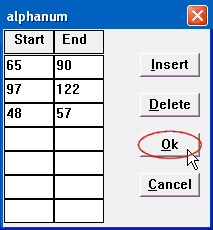Sets
A set is a user-defined set of byte (8-bit) or double-byte (16-bit) values. A byte is a fundamental unit of computer storage that can have 256 possible values (0 through 255). A double-byte value can have 65536 (256 * 256) values (0 .. 65535).
To define or modify a set :
- Select the Definitions | Sets menu option (8- or 16-bit).
- In the Sets dialog, select the set name (tag) - if adding a new set, enter the new set tag.
- Press the Enter key or the Select button.
- A second dialog will appear with the user-defined set tag at the top :

In the second dialog, enter the values associated with the set. An entry must be made in the left column, labeled "Start". Entry in the "End" column is optional - it allows the user to define a range of byte values. Each row in this dialog corresponds to a byte value / range.
The secondary dialog for sets has a special help dialog (press F1) that accepts keyboard characters and converts them to the appropriate Start / End values :

This way, the user doesn't need to know or look up the ASCII or Unicode values for any keyboard characters.
Examples of 8-bit sets, and their corresponding values :
anything8
0 - 255 (a range including all possible values)
whitespace
9, 10, 13, 32 (tab, line feed, carriage return, blank)
alphanum - alphanumeric characters
| 65 - 90 | (A-Z) |
| 97 - 122 | (a-z) |
| 30 - 39 | (0-9) |
Example of a 16-bit set :
anything16
0 - 65535 (a range including all possible values)
Notes
- If the user enters a start byte value greater than the end value, it will still generate a valid range. In other words, range 7 through 9 is the same range as 9 through 7.
- Data Splitter does not currently check for duplicates or overlaps of byte values / ranges.